Marbled Murrelet Conservation Research
My research group at the University of Victoria has been involved in Marbled Murrelet research, conservation and management in British Columbia and in the U.S. since 1990. Here are a few links showing the application of our research. For a more complete list of my Marbled Murrelet publications click here: MaMu Publications
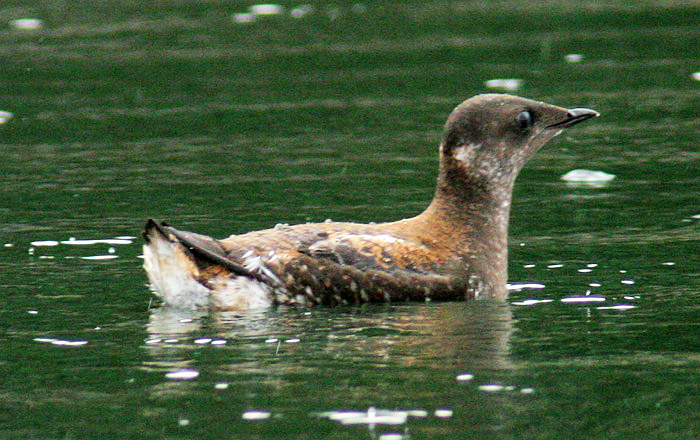
A Marbled Murrelet in alternate (breeding) plumage. Photo: © Alan Burger
Most recently Alan led a gap analysis to identify research priorities for managing Marbled Murrelets in British Columbia:
Burger, A.E., F.L. Waterhouse, and J.L. Cragg. 2020. Research options to address knowledge gaps on Marbled Murrelet terrestrial habitat requirements. Prov. B.C., Victoria, B.C. Tech. Rep. 130. URL: http://a100.gov.bc.ca/pub/eirs/viewDocumentDetail.do?fromStatic=true&repository=BDP&documentId=15370
Alan was the lead author of the COSEWIC status report for the Marbled Murrelet in Canada and a contributor to the 2014 MaMu Recovery Strategy:
COSEWIC. 2012. COSEWIC assessment and status report on the Marbled Murrelet Brachyramphus marmoratus in Canada. Committee on the Status of Endangered Wildlife in Canada. Ottawa. Available at: COSEWIC MaMu Status Report
Environment Canada. 2014. Recovery Strategy for the Marbled Murrelet (Brachyramphus marmoratus) in Canada. Species at Risk Act Recovery Strategy Series. Environment Canada, Ottawa. v + 49 pp. URL: http://www.sararegistry.gc.ca/virtual_sara/files/plans/rs_guillemot_marbre_marbled_murrelet_0614_e.pdf
Extensive research in Clayoquot Sound contributed to the management of Marbled Murrelets in this Biosphere Reserve, and the protection of large areas of murrelet nesting habitat.
Burger, A. E. and T. A. Chatwin (eds.). 2002. Multi-scale studies of populations, distribution and habitat associations of Marbled Murrelets in Clayoquot Sound, British Columbia. Ministry of Water, Land and Air Protection, Victoria, BC. (ISBN 0-7726-4739-9). Available at: Clayoquot Compendium
Alan drafted the Marbled Murrelet account within the Identified Wildlife Management Strategy (part of the BC Forest and Range Practices Act).
IWMS. 2004. Marbled Murrelet Brachyramphus marmoratus. Identified Wildlife Management Strategy: Accounts and Measures for Managing Identified Wildlife. Ministry of Enviroment, Victoria, BC. Available at: http://www.env.gov.bc.ca/wld/frpa/iwms/documents/Birds/b_marbledmurrelet.pdf
Our research was also applied in the Conservation Assessment published by the Canadian Marbled Murrelet Recovery Team, the precursor to the Canadian Marbled Murrelet Recovery Strategy. Alan was the author of the biological review – Part A of the Marbled Murrelet Conservation Assessment.
Burger, A. E. 2002. Conservation assessment of Marbled Murrelets in British Columbia, Part A: review of the biology, populations, habitat associations, and conservation. Technical Report Series No. 387, Canadian Wildlife Service, Delta, BC. Available at: Cons Assess Part A
The biological review was followed by a Management Strategy – Part B of the Marbled Murrelet Conservation Assessment – this forms the basis for the current (2014) Recovery Strategy.
CMMRT (Canadian Marbled Murrelet Recovery Team). 2003. Marbled Murrelet Conservation Assessment 2003, Part B – Marbled Murrelet Recovery Team advisory document on conservation and management. Canadian Wildlife Service, Delta, BC. Available at: Cons Assess Part B
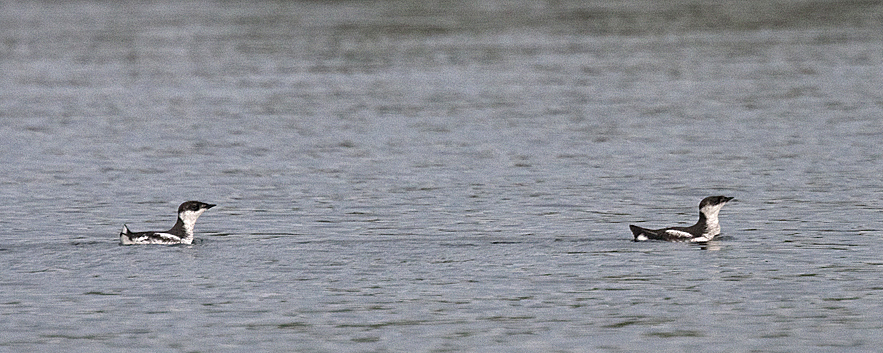
Marbled Murrelets in their basic (non-breeding) plumage. Photo: © Alan Burger
Alan has contributed to management reviews of the Marbled Murrelet in Washington, Oregon, California and Alaska. These compendia included many aspects of our UVic research. Here is a sample:
Raphael, M. G., G. A. Falxa, and A. E. Burger. 2018. Chapter 5: Marbled Murrelet. Pp. 301-350 (Vol. 1) in Spies, T.A.; Stine, P.A.; Gravenmier, R.; Long, J.W.; Reilly, M.J. (tech. coords.) Synthesis of science to inform land management within the Northwest Forest Plan area. Gen. Tech. Rep. PNW-GTR-966. Portland, OR: U.S. Department of Agriculture, Forest Service, Pacific Northwest Research Station. URL: https://www.fs.usda.gov/pnw/publications/synthesis-science-inform-land-management-within-northwest-forest-plan-area
Plissner, J. H., B. A. Cooper, R. H. Day, P. M. Sanzenbacher, A. E. Burger, and M. G. Raphael. 2015. A review of Marbled Murrelet research related to nesting habitat use and nest success. Unpublished report, Prepared for: Oregon Department of Forestry, Salem, OR. ABR, Inc.—Environmental Research & Services, Forest Grove, Oregon. URL: https://www.oregon.gov/ODF/Documents/WorkingForests/ReviewofMAMUResearchRelatedToNestingHabitatUseandNestSuccess.pdf
Piatt, J.F., K.J. Kuletz, A.E. Burger, S.A. Hatch, V.L. Friesen, T.P. Birt, M.L. Arimitsu, G.S. Drew, A.M.A. Harding, and K.S. Bixler. 2007. Status Review of the Marbled Murrelet (Brachyramphus marmoratus) in Alaska and British Columbia. U.S. Geological Survey Open-File Report 2006-1387. Available at: http://pubs.usgs.gov/of/2006/1387/
McShane, C., T. Hamer, H. Carter, G. Swartzman, V. Friesen, D. Ainley, R. Tressler, K. Nelson, A. Burger, L. Spear, T. Monagen, R. Martin, L. Henkel, K. Prindle, C. Strong, and J. Keany. 2004. Evaluation report for the 5-year status review of the Marbled Murrelet in Washington, Oregon, and California. Unpublished report, prepared for U.S. Fish and Wildlife Service, Region 1. Portland Oregon. EDAW, Inc., Seattle, WA. Available at: McShane et al. 2004
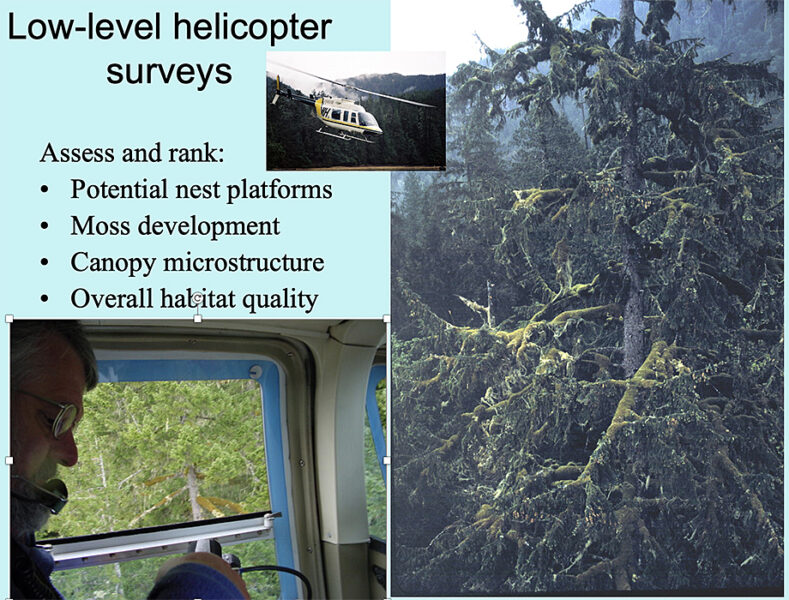
Alan has also been closely involved in the development and application of helicopter aerial surveys and air photo interpretation as tools in identifying and managing murrelet nesting habitat in British Columbia. These are now common methods used by forest companies and the B.C. government for assessing murrelet nesting habitat in many parts of B.C. Here are some products of that work:
Burger, A.E. Waterhouse, F.L., Deal, J.A., Lank, D.B., & Donald, D.S., 2018. The reliability and application of methods used to predict suitable nesting habitat for Marbled Murrelets. Journal of Ecosystems and Management 18(1):1–18. URL: https://jem-online.org/forrex/index.php/jem/issue/view/55
Burger, A.E., F.L. Waterhouse, A. Donaldson, C. Whittaker, and D.B. Lank. 2009. New methods for assessing Marbled Murrelet nesting habitat: Air photo interpretation and low-level aerial surveys. BC Journal of Ecosystems and Management 10(1):4–14. URL: http://forrex.org/sites/default/files/publications/jem_archive/ISS50/vol10_no1_art2.pdf
Burger, A. E. (ed.) 2004. Standard methods for identifying and ranking nesting habitat of Marbled Murrelets (Brachyramphus marmoratus) in British Columbia using air photo interpretation and low-level aerial surveys. BC Ministry of Water, Land and Air Protection, Victoria, BC, and Ministry of Forests, Nanaimo, BC. http://www.env.gov.bc.ca/wld/documents/fia_docs/mamu_standard.pdf
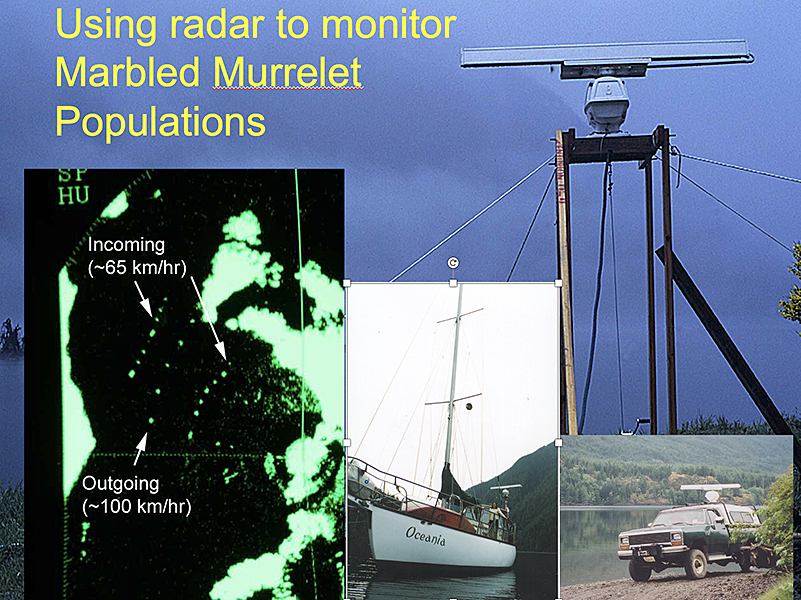
X-band ship’s radar has proved to be a powerful tool to track and count Marbled Murrelets as they fly from the sea to their inland nest sites at dawn and dusk.
Our radar work in the 1990s and 2000s was instrumental in showing that the numbers of Marbled Murrelets entering watersheds was closely correlated with the area of existing suitable forest habitat in these watersheds. These data also showed that when logging of old-growth habitat takes place the number of breeding murrelets will decline – the birds do not pack into the remaining habitat in higher densities.
Burger, A.E. and F.L. Waterhouse. 2009. Relationships between habitat area, habitat quality, and populations of nesting Marbled Murrelets. BC Journal of Ecosystems and Management 10(1):101–112. URL: http://jem-online.org/index.php/jem/article/view/415
Burger, A. E. 2001. Using radar to estimate populations and assess habitat associations of Marbled Murrelets. Journal of Wildlife Management 65:696-715. pdf: Burger 2001 JWM MaMu Radar
Burger, A. E., T. A. Chatwin, S. A. Cullen, N. P. Holmes, I. A. Manley, M. H. Mather, B. K. Schroeder, J. D. Steventon, J. E. Duncan, P. Arcese, and E. Selak. 2004. Application of radar surveys in the management of nesting habitat of Marbled Murrelets Brachyramphus marmoratus. Marine Ornithology 32:1-11. Available at: http://www.marineornithology.org
A review of nesting data also showed that under favourable circumstances, murrelets do not regularly re-use nest sites, implying that large areas of suitable habitat are needed to maintain healthy breeding populations. When murrelets are obliged by limited habitat to re-use nest sites they suffer increased nest predation (see the review by Plissner et al. listed above).
Burger A. E., I. A. Manley, M. Silvergieter, D. B. Lank, K. M. Jordan, T. D. Bloxton and M. G. Raphael. 2009. Re-use of nest sites by Marbled Murrelets (Brachyramphus marmoratus) in British Columbia. Northwestern Naturalist 90:217-226. pdf: Burger et al. 2009 re-nesting NW Nat
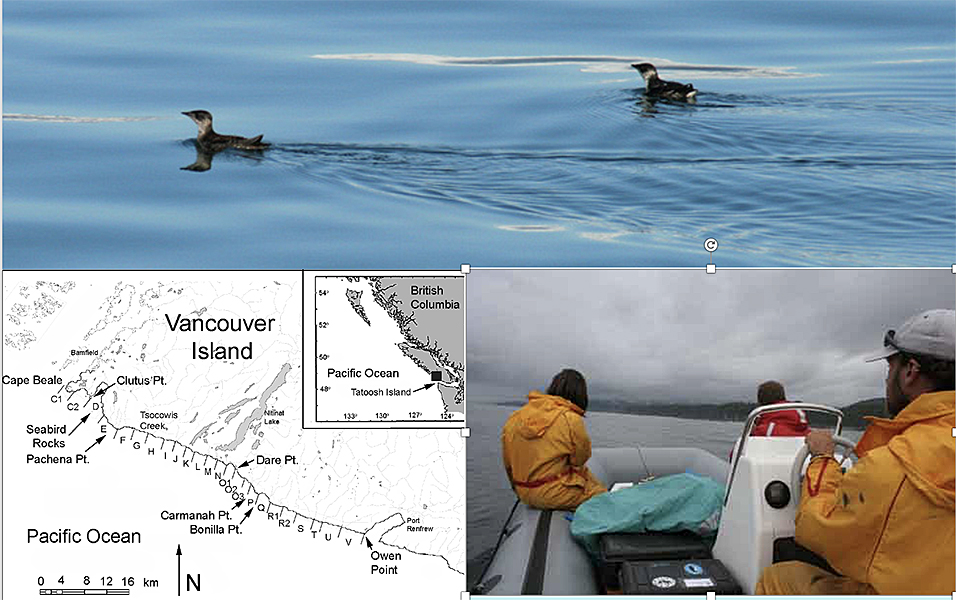
At-sea surveys off the West Coast Trail, SW Vancouver Island revealed marine habitat use, relationships to nearby forest nesting habitat, effects of ocean variability and population trends.
Students working under Alan’s supervision have also contributed significantly to MaMu conservation, beginning in 1990 with the discovery of the first murrelet nest in BC by UVic student Irene Manley. Other examples (See our publications page):
- Rob Ronconi’s PhD work focused on the links between marine (foraging) and inland (nesting) habitat to identify factors useful in determining factors limiting murrelet populations.
- Kathy Kuletz’s PhD work at UVic underlies her continues work on murrelets in Alaska with the US Fish & Wildlife Service.
- Jenna Cragg’s MSc study on Kodiak Island, AK showed the value of automated audio recorders coupled with radar in monitoring murrelet populations and occurrence in habitat.
- Michelle Masselink’s MSc study of Steller’s Jays showed the increased risk of nest predation to murrelets nesting close to clearcut edges and roads.
- Volker Bahn’s Masters study (co-supervised with Philipps-Universität Marburg, Germany) developed reliable algorithms for predicting MaMu nesting habitat
- Sharon Mansiere (Dechesne) provided the most comprehensive study to date of MaMu vocalizations and how they might be applied in monitoring.
- Nathan Henze worked with staff of Pacific Rim National Park Reserve to investigate the effects of boat traffic on the behaviour and distribution of murrelets during the breeding season.
Many other projects have contributed to the conservation and management of Marbled Murrelets – see the Marbled Murrelet Publications page: click here.
